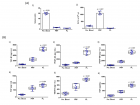Abstract
Review Article
Vigour of CRISPR/Cas9 Gene Editing in Alzheimer’s Disease
Jes Paul*
Published: 05 October, 2018 | Volume 2 - Issue 2 | Pages: 047-051
Ailment repairing regiments has turn out to be arduous, despite a plenty of understanding and knowledge acquired in the past relating to the molecular underpinnings of Alzheimer’s disease (AD. Umpteen clinical experiments targeting the fabrication and accumulation have been turned fruitless to fit potency standards. The tests aiming beta-amyloid hypothesis also turned futile making it exigent for further handling tactics. The new emanation of a comparably candid, economical, and punctilious system known as gene editing have showed light in path of cure for AD by CRISPR/Cas9 gene editing. Being a straight approach this procedure has already shown assurance in other neurological disorders too such as Huntington’s disease. This review standpoint the immanent service of CRISPR/Cas9 as a remedial option for AD by aiming on specific genes inclusive of those that induce early-onset AD, as well as those that are substantial risk components for late-onset AD such as the apolipoprotein E4 (APOE4) gene.
Read Full Article HTML DOI: 10.29328/journal.jnnd.1001014 Cite this Article Read Full Article PDF
Keywords:
Alzheimer’s disease; CRISPR/Cas9; Gene editing; Treatment; Huntington’s disease; iPSC neurons
References
- Jones EL, Kalaria RN, Sharp SI, O’Brien JT, Francis PT, et al. Genetic associations of autopsy-confirmed vascular dementia subtypes. Dement GeriatrCognDisord. 2011; 31: 247–253. Ref.: https://goo.gl/VrBuco
- Mirra SS, Heyman A, McKeel D, Sumi SM, Crain BJ, et al. The consortium to establish a registry for Alzheimer’s disease (CERAD) part II. Standardization of the neuropathological assessment of Alzheimer’s disease. Neurol. 1991; 41: 479–486. Ref.: https://goo.gl/GZ4PKL
- Terry RD, Masliah E, Salmon DP, Butters N, DeTeresa R, et al. Physical basis of cognitive alterations in Alzheimer’s disease: synapse loss is the major correlate of cognitive impairment. Ann Neurol. 1991; 30: 572–580. Ref.: https://goo.gl/UBTCiK
- DeKosky ST, Scheff SW, Styren SD. Structural correlates of cognition in dementia: Quantification and assessment of synapse change. Neurodegeneration. 1996; 5: 417–421. Ref.: https://goo.gl/vxUsux
- Coleman PD, Yao PJ. Synaptic slaughter in Alzheimer’s disease. Neurobiol Aging. 2003; 24: 1023–1027. Ref.: https://goo.gl/nezMzY
- Lacor PN, Buniel MC, Chang L, Fernandez SJ, Gong Y, et al. Synaptic targeting by Alzheimer’s-related amyloid beta oligomers. J Neurosci. 2004; 24: 10191–10200. Ref.: https://goo.gl/st1b1F
- Lambert MP, Barlow AK, Chromy BA, Edwards C, Freed R, et al. Diffusible, nonfibrillar ligands derived from Abeta1-42 are potent central nervous system neurotoxins. Proc Natl Acad Sci U S A. 1998; 95: 6448–6453. Ref.: https://goo.gl/wyxW1e
- McLean CA, Cherny RA, Fraser FW, Fuller SJ, Smith MJ, et al. Soluble pool of Abeta amyloid as a determinant of severity of neurodegeneration in Alzheimer’s disease. Ann Neurol. 1999; 46: 860–866. Ref.: https://goo.gl/ETDLih
- Broersen K, Rousseau F, Schymkowitz J. The culprit behind amyloid beta peptide related neurotoxicity in Alzheimer’s disease: Oligomer size or conformation? Alzheimers Res Ther. 2010; 2: 12. Ref.: https://goo.gl/sSVGiS
- Rohn TT, Kim N, Isho NF, Mack JM. The Potential of CRISPR/Cas9 Gene Editing as a Treatment Strategy for Alzheimer’s Disease. J Alzheimers Dis Parkinsonism. 2018; 8: 439. Ref.: https://goo.gl/7NDf8r
- Mojica FJ, Diez-Villasenor C, Garcia-Martinez J, Soria E. Intervening sequences of regularly spaced prokaryotic repeats derive from foreign genetic elements. J MolEvol. 2005; 60: 174–182. Ref.: https://goo.gl/oKLqZy
- Pourcel C, Salvignol G, Vergnaud G. CRISPR elements in Yersinia pestis acquire new repeats by preferential uptake of bacteriophage DNA, and provide additional tools for evolutionary studies. Microbiology. 2005; 151: 653–663. Ref.: https://goo.gl/wpw3tY
- Barrangou R, Fremaux C, Deveau H, Richards M, Boyaval P, et al. CRISPR provides acquired resistance against viruses in prokaryotes. Science. 2007; 315: 1709–1712. Ref.: https://goo.gl/jRYzbU
- Bolotin A, Quinquis B, Sorokin A, Ehrlich SD. Clustered regularly interspaced short palindrome repeats (CRISPRs) have spacers of extrachromosomal origin. Microbiology. 2005; 151: 2551–2561. Ref.: https://goo.gl/j9tdyj
- Deltcheva E, Chylinski K, Sharma CM, Gonzales K, Chao Y, et al. CRISPR RNA maturation by trans-encoded small RNA and host factor RNase III. Nature. 2011; 471: 602–607. Ref.: https://goo.gl/LgTULX
- Saudou F, Humbert S. The biology of huntingtin. Neuron. 2016; 89: 910–926. Ref.: https://goo.gl/WGjZZv
- Bates GP, Dorsey R, Gusella JF, Hayden MR, Kay C, et al. Huntington disease. Nat Rev Dis Primers. 2015; 1: 15005. Ref.: https://goo.gl/sYTJU7
- Dabrowska M, Juzwa W, Krzyzosiak WJ, Olejniczak M. Precise excision of the CAG tract from the huntingtin gene by cas9 nickases. Front Neurosci. 2018; 12: 75. Ref.: https://goo.gl/juHxQe
- Schellenberg GD, Bird TD, Wijsman EM, Orr HT, Anderson L, et al. Genetic linkage evidence for a familial Alzheimer’s disease locus on chromosome 14. Science. 1992; 258: 668–671. Ref.: https://goo.gl/q2EmRY
- Levy-Lahad E, Wijsman EM, Nemens E, Anderson L, Goddard KA, et al. A familial Alzheimer’s disease locus on chromosome 1. Science. 1995; 269: 970–973. Ref.: https://goo.gl/2SYDSQ
- Vetrivel KS, Zhang YW, Xu H, Thinakaran G. Pathological and physiological functions of presenilins. MolNeurodegener. 2006; 1: 4. Ref.: https://goo.gl/Dbk6wU
- Pires C, Schmid B, Petræus C, Poon A, Nimsanor N, et al. Generation of a gene-corrected isogenic control cell line from an Alzheimer’s disease patient iPSC line carrying a A79V mutation in PSEN1. Stem Cell Res. 2016; 17: 285–288. Ref.: https://goo.gl/Bns14i
- Poon A, Schmid B, Pires C, Nielsen TT, Hjermind LE, et al. Generation of a gene-corrected isogenic control hiPSC line derived from a familial Alzheimer’s disease patient carrying a L150P mutation in presenilin 1. Stem Cell Res. 2016; 17: 466–469. Ref.: https://goo.gl/TAsC6J
- György B, Lööv C, Zaborowski M, Takeda S, Kleinstiver B, et al. CRISPR/Cas9 mediated disruption of the swedish APP allele as a therapeutic approach for early-onset alzheimer’s disease. MolTher Nucleic Acids. 2018; 11: 429–440. Ref.: https://goo.gl/5Q2R3R
- Sun J, Carlson-Stevermer J, Das U, Shen M, Delenclos M, et al. A CRISPR/Cas9 based strategy to manipulate the Alzheimer’s amyloid pathway. 2018 bioRxiv. Ref.: https://goo.gl/3NdTq9
- Das U, Scott DA, Ganguly A, Koo EH, Tang Y, et al. Activity-induced convergence of APP and BACE-1 in acidic microdomains via an endocytosis-dependent pathway. Neuron. 2013; 79: 447–460. Ref.: https://goo.gl/Q3nKnq
- Eisenstein M. Genetics: Finding risk factors. Nature. 2011; 475: S20–22. Ref.: https://goo.gl/GNjWRL
- Weisgraber KH, Rall SC, Jr, Mahley RW. Human E apoprotein heterogeneity. Cysteine-arginine interchanges in the amino acid sequence of the apo-E isoforms. J Biol Chem. 1981; 256: 9077–9083. Ref.: https://goo.gl/dn7yof
- Farrer LA, Cupples LA, Haines JL, Hyman B, Kukull WA, et al. Effects of age, sex, and ethnicity on the association between apolipoprotein E genotype and Alzheimer disease. A meta-analysis. APOE and alzheimer disease meta-analysis consortium. JAMA. 1997; 278: 1349–1356. Ref.: https://goo.gl/VTAWzn
- Saunders AM, Strittmatter WJ, Schmechel D, George-Hyslop PH, Pericak-Vance MA, et al. Association of apolipoprotein E allele epsilon 4 with late-onset familial and sporadic Alzheimer’s disease. Neurol. 1993; 43: 1467–1472. Ref.: https://goo.gl/nTC61T
- Kanekiyo T, Xu H, Bu G. ApoE and Aβ in Alzheimer’s disease: accidental encounters or partners? Neuron. 2014; 81: 740–754. Ref.: https://goo.gl/vuR6oA
- Wang C, Najm R, Xu Q, Jeong DE, Walker D, et al. Gain of toxic apolipoprotein E4 effects in human iPSC-derived neurons is ameliorated by a small-molecule structure corrector. Nat Med. 2018; 24: 647–657. Ref.: https://goo.gl/rvcjWZ
- Dong LM, Weisgraber KH. Human apolipoprotein E4 domain interaction. Arginine 61 and glutamic acid 255 interact to direct the preference for very low density lipoproteins. J Biol Chem. 1996; 271: 19053–19057. Ref.: https://goo.gl/bff8mX
- Prince M, Comas-Herrera A, Knapp M, Guerchet M, Karagiannidou M. Coverage, quality and costs now and in the future. Alzheimer’s Disease International; London: 2016. World Alzheimer Report 2016. Improving healthcare for people living with dementia.
Similar Articles
-
The “Calcium Paradox” Due To Ca2+/Camp Interaction: New Insights for the Neuroscience FieldLeandro Bueno Bergantin*, Afonso Caricati-Neto. The “Calcium Paradox” Due To Ca2+/Camp Interaction: New Insights for the Neuroscience Field. . 2017 doi: 10.29328/journal.jnnd.1001002; 1: 012-015
-
Protective functions of AEURA in Cell Based Model of Stroke and Alzheimer diseaseJigar Modi,Ahmed Altamimi,Ashleigh Morrell,Hongyuan Chou,Janet Menzie,Andrew Weiss,Michael L Marshall, Andrew Li,Howard Prentice*,Jang-Yen Wu*. Protective functions of AEURA in Cell Based Model of Stroke and Alzheimer disease. . 2017 doi: 10.29328/journal.jnnd.1001003; 1: 016-023
-
Direct Carotid Puncture for Flow Diverter Stent InsertionBhogal P*,Phillips TJ, Makalanda HLD. Direct Carotid Puncture for Flow Diverter Stent Insertion. . 2017 doi: 10.29328/journal.jnnd.1001004; 1: 024-028
-
Lateralized Cerebral Amyloid Angiopathy presenting with recurrent Lacunar Ischemic StrokeYi Li*, Ayman Al-Salaimeh,Elizabeth DeGrush,Majaz Moonis*. Lateralized Cerebral Amyloid Angiopathy presenting with recurrent Lacunar Ischemic Stroke. . 2017 doi: 10.29328/journal.jnnd.1001005; 1: 029-032
-
Comorbidity of alcohol dependence with attention-deficit/hyperactivity disorder and the role of executive dysfunctionsCaterina Pistarini*,Gloria Tosi,Giovanni Vittadini,Ines Giorgi,Elena Fiabane,Paola Palladino. Comorbidity of alcohol dependence with attention-deficit/hyperactivity disorder and the role of executive dysfunctions . . 2018 doi: 10.29328/journal.jnnd.1001008; 2: 001-010
-
Herpes simplex virus (HSV)-1 encephalitis can induce chronic anti-N-methyl-D-aspartate receptor (NMDAR) encephalitisSusanne Buechner*,Gabriele J Sixt,Igor Florio. Herpes simplex virus (HSV)-1 encephalitis can induce chronic anti-N-methyl-D-aspartate receptor (NMDAR) encephalitis. . 2018 doi: 10.29328/journal.jnnd.1001012; 2: 033-038
-
Neurobiology of Common Sleep DisordersZhao Liu*,Abdullah Tolaymat,Sreenivas K Avula. Neurobiology of Common Sleep Disorders. . 2018 doi: 10.29328/journal.jnnd.1001013; 2: 039-046
-
Vigour of CRISPR/Cas9 Gene Editing in Alzheimer’s DiseaseJes Paul*. Vigour of CRISPR/Cas9 Gene Editing in Alzheimer’s Disease. . 2018 doi: 10.29328/journal.jnnd.1001014; 2: 047-051
-
Mimicking multiple sclerosis - Ghost tumor that comes and goes in different parts of the brain without any treatmentLong Ching*,Ming Him Yuen,Tak Lap Poon,Fung Ching Cheung,Shun Hin Ting,Wing Chi Fong. Mimicking multiple sclerosis - Ghost tumor that comes and goes in different parts of the brain without any treatment. . 2019 doi: 10.29328/journal.jnnd.1001020; 3: 087-090
-
Long-term clinical outcome of minimally invasive versus open single-level transforaminal lumbar interbody fusion for degenerative lumbar diseases with a minimum follow-up of 2 years: A meta-analysis protocolJohan L Heemskerk*,Oluwaseun Oluwadara Akinduro,William Clifton,Alfredo Quinones-Hinojosa,Kingsley O Abode-Iyamah. Long-term clinical outcome of minimally invasive versus open single-level transforaminal lumbar interbody fusion for degenerative lumbar diseases with a minimum follow-up of 2 years: A meta-analysis protocol. . 2019 doi: 10.29328/journal.jnnd.1001021; 3: 091-095
Recently Viewed
-
Viral meningitis in pregnancy: A case reportRuth Roseingrave*,Savita Lalchandani . Viral meningitis in pregnancy: A case report. Clin J Obstet Gynecol. 2020: doi: 10.29328/journal.cjog.1001063; 3: 121-122
-
Vaginal and endometrial metastasis of primary cutaneous malignant melanomaMaria Boia Martins*,Francisca Morgado,Nuno Oliveira,Filomena Ramos. Vaginal and endometrial metastasis of primary cutaneous malignant melanoma. Clin J Obstet Gynecol. 2020: doi: 10.29328/journal.cjog.1001062; 3: 120-120
-
Universal testing for severe acute respiratory syndrome coronavirus 2 upon admission to three labor and delivery units in Santa Clara County, CASophia Yang,Rishi Bhatnagar,James Byrne,Andrea Jelks*. Universal testing for severe acute respiratory syndrome coronavirus 2 upon admission to three labor and delivery units in Santa Clara County, CA. Clin J Obstet Gynecol. 2020: doi: 10.29328/journal.cjog.1001060; 3: 109-113
-
Pregnancy complicated with deficiency of antithrombin: Review of current literatureMiroslava Gojnic,Zoran Vilendecic,Stefan Dugalic,Igor Pantic,Jovana Todorovic,Milan Perovic,Mirjana Kovac,Irena Djunic,Predrag Miljic,Jelena Dotlic*. Pregnancy complicated with deficiency of antithrombin: Review of current literature. Clin J Obstet Gynecol. 2020: doi: 10.29328/journal.cjog.1001059; 3: 103-108
-
The influence of HBV or HCV infections on the pregnancy courseTadeusz Wojciech Lapiński*. The influence of HBV or HCV infections on the pregnancy course. Clin J Obstet Gynecol. 2020: doi: 10.29328/journal.cjog.1001058; 3: 098-102
Most Viewed
-
Evaluation of Biostimulants Based on Recovered Protein Hydrolysates from Animal By-products as Plant Growth EnhancersH Pérez-Aguilar*, M Lacruz-Asaro, F Arán-Ais. Evaluation of Biostimulants Based on Recovered Protein Hydrolysates from Animal By-products as Plant Growth Enhancers. J Plant Sci Phytopathol. 2023 doi: 10.29328/journal.jpsp.1001104; 7: 042-047
-
Sinonasal Myxoma Extending into the Orbit in a 4-Year Old: A Case PresentationJulian A Purrinos*, Ramzi Younis. Sinonasal Myxoma Extending into the Orbit in a 4-Year Old: A Case Presentation. Arch Case Rep. 2024 doi: 10.29328/journal.acr.1001099; 8: 075-077
-
Feasibility study of magnetic sensing for detecting single-neuron action potentialsDenis Tonini,Kai Wu,Renata Saha,Jian-Ping Wang*. Feasibility study of magnetic sensing for detecting single-neuron action potentials. Ann Biomed Sci Eng. 2022 doi: 10.29328/journal.abse.1001018; 6: 019-029
-
Pediatric Dysgerminoma: Unveiling a Rare Ovarian TumorFaten Limaiem*, Khalil Saffar, Ahmed Halouani. Pediatric Dysgerminoma: Unveiling a Rare Ovarian Tumor. Arch Case Rep. 2024 doi: 10.29328/journal.acr.1001087; 8: 010-013
-
Physical activity can change the physiological and psychological circumstances during COVID-19 pandemic: A narrative reviewKhashayar Maroufi*. Physical activity can change the physiological and psychological circumstances during COVID-19 pandemic: A narrative review. J Sports Med Ther. 2021 doi: 10.29328/journal.jsmt.1001051; 6: 001-007

HSPI: We're glad you're here. Please click "create a new Query" if you are a new visitor to our website and need further information from us.
If you are already a member of our network and need to keep track of any developments regarding a question you have already submitted, click "take me to my Query."

















































































































































